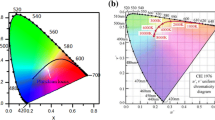Abstract
Luminescent nanoparticles such as quantum dots (QDs) are beginning to appear in SSL devices and other commercial products. The allure of QDs in SSL these applications is the potential to provide enhanced device performance (e.g., improved energy efficiency, better color rendering properties, etc.) than is possible with conventional technologies. When used in SSL and other applications, QDs are typically incorporated into or coated onto a solid organic or inorganic matrix and then are excited using external stimuli (e.g., blue light with a maximum wavelength of 450 nm). This structure is vastly different from the colloidal environment in which QDs are typically synthesized and characterized. Bridging the gap between the measurements typically acquired by QD providers and those needed by potential end-users is currently difficult due to the absence of agreed upon standard test methods. Measurements taken in colloidal QD suspensions often do not translate to solid-phase material characterizations due to a variety of factors including sample preparation methods (e.g., temperature, solvents, etc), QD concentrations, and effects arising from the presence of the solid matrix. Additionally, solid samples are more likely to exhibit diffuse reflectance and/or diffuse transmittance necessitating the use of an integrating sphere and a computer-controlled spectrometer to acquire accurate readings. This paper discusses the development of a standard test method to measure the quantum efficiency of QDs contained in solid organic and inorganic matrices. This standard is being developed under the auspices of the International Electrotechnical Commission, Technical Committee 113 on Nano-electrotechnologies.
Similar content being viewed by others
References
QD Vision Press Release, http://www.qdvision.com/news_090506.html.
A.T.R. Williams and S.A. Winfield, Analyst 108, 1067 (1983).
R.F. Kubin and A.N. Fletcher, J. Luminescence 27, 455 (1983).
D. Magde, J.H. Brannon, T.L. Cremers, J. Olmsted, J. Phys. Chem. 83, 696 (1979).
T. Karstens and K. Kobs, J. Phys. Chem. 84, 1871 (1980).
J.C. deMello, H. F. Wittman and R.H. Friend, Advanced Materials 9, 230 (1997).
L.S. Rohwer and J. Martin, J. Luminescence 115, 77 (2005).
T.-S. Ahn, R.O. Al-Kaysi, A.M. Muller, K.M. Wentz, and C.J. Bardeen, Rev. Sci. Instrum. 78, 086105 (2007).
A.Y. Nazzal, X. Wang, L. Qu, W. Yu, Y. Wang, X. Peng, and M. Xiao, J. Phys Chem. B 108, 5507 (2004).
B.O. Dabbouse, J. Rodriguez-Viejo, F.V. Mikulec, J.R. Heine, H. Mattoussi, R. Ober, K.F. Jense, and M.G. Bawendi, J. Phys. Chem. B 101, 9463 (1997).
Author information
Authors and Affiliations
Rights and permissions
About this article
Cite this article
Davis, J.L., Coe-Sullivan, S., Shchekin, O. et al. Standards Development for the Characterization of Quantum Dot Suspensions and Solids. MRS Online Proceedings Library 1207, 409 (2009). https://doi.org/10.1557/PROC-1207-N04-09
Received:
Accepted:
Published:
DOI: https://doi.org/10.1557/PROC-1207-N04-09




